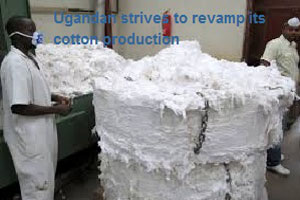
Ugandan strives to revamp its cotton production
YarnsandFibers News Bureau 2017-01-02 14:00:00 – AfricaCotton is Uganda’s third largest export crop after coffee and tea, as well as the main source of income for some 250,000 households. After the Ugandan government launching a campaign to support cotton and other local industries many of the farmers, hopes are high that the industry would embrace a boom.
Before the onset of stiff competition from Asia, Uganda’s textile industry had been a flourishing industry way back to the 1960s. There were structures and systems right from growing to marketing cotton, and extension workers could traverse villages teaching farmers how to plant and harvest cotton.
The price of cotton at the farm-gate was paid by the ginneries or co-operatives in most cases, and the government would provide a subsidy. This system always encouraged farmers as a good price was guaranteed.
At the national level there was the Lint Marketing Board (LMB), which had the monopoly to trade in all the lint and cotton seed. As a result, production reached the highest level, of 470,000 bales of lint, in 1969/70, according to government figures.
The government is striving to revamp the sector as the country spends 888 million dollars on annual textile imports, money that would have been used to revamp the industry locally. The government is arguing the crop can still be one of the country’s top foreign exchange earners and generate much of the revenue internally.
Earlier this year, President Yoweri Museveni called for supporting Uganda’s local industries and directed all uniforms for the army, the police and prisons service be bought locally.
Banking on a recent decision by East African Community member states to ban importation of used clothes, Uganda believes it can still reap big from the crop.
The country is already reaping from the available international markets where it can export its textile materials tariff and quota free.
According to CDO, Uganda now has 40 ginneries and a total installed seasonal ginning capacity of around 1 million bales of lint production (200,000 tonnes). This is above the maximum production achieved in the last two decades.
Despite many opportunities awaiting local farmers, The government is urged to help farmers cope with the harsh climate change effects besides declining soil fertility.
As the last two seasons have not been good due to prolonged dry spells and infertile soils, Hence farmers need to be provided with good-quality seeds and fertilizers to ensure good yields.
In 2015, Uganda cotton exports rose to 63,512 tonnes from 40,671 tonnes in 2014, but the value for exported cotton dropped to 20 million U.S. dollars in 2015 from 22 million dollars in 2014.
Market Intelligence
Ask for free sample Report

experience
Customer Base
dedicated team
Countries Served Worldwide









